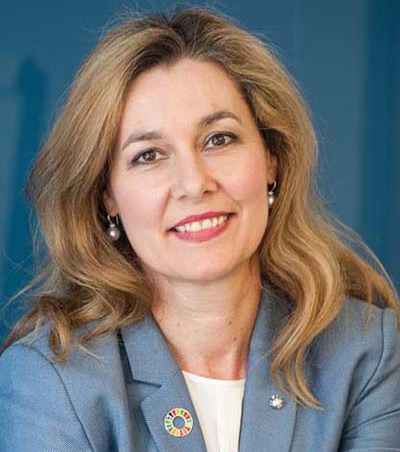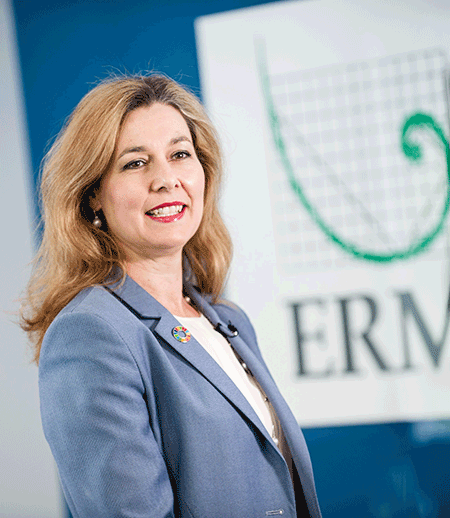2021 CEOs Who 'Get It'


Keryn James
CEO
ERM
London
ERM is a leading global environmental, health and safety and sustainability consultancy firm with about 5,000 employees in 47-plus countries. ERM works with clients in a variety of sectors, including technology, oil and gas, power, finance, chemicals, pharmaceuticals, manufacturing, and mining to address their critical EHS and sustainability challenges.

Describe your personal journey to becoming a CEO who “gets it.”
Throughout my consulting career, I have worked on projects in many different settings, from refineries to mine sites to very remote communities in Africa and Asia. I have the privilege of leading a business that has a diverse range of services from site investigation and remediation and decommissioning to stakeholder engagement, product stewardship, due diligence, strategy and safety risk assessment. The diversity of sectors, geographies, cultures and services have exposed me to a very wide array of risks, risk tolerance, and management of health and safety.
This has helped me to understand how important it is for safety to be a “value” (rather than a process or a priority) because values are universal, no matter the culture, language or location.
ERM is a partnership model business and partners at ERM have always had the primary leadership accountability for making sure that work is done safely. As you are promoted within ERM, your responsibilities with respect to safety increase, but it is when you become a partner that you are “accountable.” When you are accountable for sending people into remote parts of Africa, a highly hazardous facility or a challenging stakeholder engagement activity, you want to be absolutely sure they will be safe, and it becomes part of the way you think about the work that we do and how we do it. It’s built into the culture of the organization.
I have worked with clients and on client facilities/projects that have demonstrated health and safety excellence, and I have been in locations where this has not been the case. In my 25-plus years, I have experienced “good” and “bad” and, in particular, I have had direct experience with the deaths of subcontractors – this loss of life never leaves you. It shapes you and changes you in ways that is very difficult to convey. The understanding that the accountability ultimately rests with me, when this happens, is something that I feel very deeply and it changes how you think and behave.
What is the biggest obstacle to safety at your organization, and how do you work to overcome it?
I think there are two things that I worry about in this regard: 1) complacency and 2) failure to manage change. In every root cause analysis that we have undertaken for incidents and near misses at ERM (and, frankly, also with our clients), some element of these two issues often comes into play. The past eight months of living in a COVID-19 world have exacerbated the change management issues in my view. We are tackling the change management dimension by reviewing processes and other factors, but the most important action is increasing the level of engagement with our leaders and teams delivering projects in the field to raise awareness and capability around recognizing change, and appropriate responses. With respect to complacency, it’s about keeping safety alive in all of our conversations and engagements with staff – whether that be at a global level, an office level or at a site level on a daily basis. It’s a constant and enduring conversation.
Why is safety a core value at your organization?
ERM’s stated purpose is to “shape a sustainable future with the world’s leading organizations.” Safe and healthy workforces are an essential component of sustainability and therefore we cannot deliver on our purpose or be successful on a sustainable basis without them. It is core to who we are and what we do, as well as our success. We need to put the safety of our people, our contractors, our clients, employees and the community first.
How do you instill a sense of safety in employees on an ongoing basis?
A number of years ago we developed “Safety AT ERM.” This is not only a set of five key elements that define our health and safety program, it is also a tagline and mantra that supports our continued journey toward safety excellence. Collectively, these elements help our entire staff to both understand and articulate the most important aspects of our overall H&S program. They also help us, as an organization, remain focused as we look to identify opportunities to improve upon our H&S performance. AT ERM includes:
- Active leadership
- Training and competency
- Emphasizing positive safety
- Risk management
- Maintaining balance
With this framework in place, we use a wide variety of engagement mechanisms to talk about and celebrate safety performance, including our safety induction process, safety shares/moments at all meetings, development of a library of safety alerts to share learnings, safety performance is recognized through our quarterly awards program, we host a Global Safety Day (which as one of our five Safety AT ERM headlines as the overall theme), and we conduct regular training. During partner and staff calls, we recognize and discuss particular safety events/issues.
How does your organization measure safety? What are the leading indicators that show you how safe your organization is, and where do you see room for improvement?
We have a global safety dashboard, which is available to all partners and staff but is reported to the executive committee at each meeting. Our internal indicators are built around our five AT ERM components and include measures of leadership engagement, subcontractor illness/injury rates, RI and TRIR, subsurface clearance/overhead intercept events, mandatory training compliance, high-risk rate reduction, safety awards (three categories), corrective action status including high-risk CAPA status. We report a subset of these indicators in our annual sustainability report. Like many organizations, we are always looking to identify leading measures of safety performance and have some longer term goals around our maturity as an organization.
What role does off-the-job safety play in your organization’s overall safety program? What types of off-the-job safety and health programs does your organization offer to employees?
Because safety is a value at ERM, we encourage our employees to adopt safe behaviors in all aspects of their lives, for their benefit and that of their families. We don’t have explicit “off the job” safety programs, but all of our material is available for use by ERM staff at home and individual offices in different locations will run events and programs that are in line with local staff demand. We actively engage families in our Global Safety Day with a children’s coloring competition and a video competition.
What have you done to support employee mental health and well-being within your organization?
ERM had a range of programs available prior to the pandemic, but COVID-19 has required us to relook at all of our mental health and well-being programs to ensure our staff is able to deal with the challenges that have been exacerbated by COVID-19. In addition to having open conversations with our staff on this topic, we have drawn on specialist expertise to advise our COVID Taskforce and executive committee, developed and rolled out mental health awareness sessions, developed and implemented training for line managers on the topic, provided access to apps such as CALM, and expanded or reinforced access to employee assistance programs where these are available in different jurisdictions around the world.
Post a comment to this article
Safety+Health welcomes comments that promote respectful dialogue. Please stay on topic. Comments that contain personal attacks, profanity or abusive language – or those aggressively promoting products or services – will be removed. We reserve the right to determine which comments violate our comment policy. (Anonymous comments are welcome; merely skip the “name” field in the comment box. An email address is required but will not be included with your comment.)


